Resurgence of the UK 18ft skiffs
As keen readers will have noticed – the 18ft skiff class in the UK has been making a comeback this season after a hiatus in 2010 when they held just one regatta before racing petered out. It was felt that it wasn’t worth organising anything for just three or four boats - a shame for a class which remains one of the most exhilarating.
According to the UK Class Secretary, Ben Clothier, the reason was principally due to a change of guard in the class with many of the longest standing teams standing down. “It was frustrating, but it wasn’t completely unexpected. One of our key protagonists had injured himself in a skiing accident and a number of the teams, who had been strong supporters of the class for the last 10 years, decided to move on mainly due to family commitments.” He points out that this also coincided with a recession.
Among these have been the Richards brothers, Andy and Dave. Andy in particular has been very active on the 18ft Skiff World Council in recent years.
It has been a similar story for Alec Mckinlay and his past European Championship winning crew on Ronstan and Ed Brown’s Wet & Wide team. “Three extremely good strong boats, internationally winning European events and championships...” states Clothier. “But naturally people move on. Now we are having to work out who the next group is and make sure the racing is organised in such a way that it attracts people who are able to sail at that kind of level and commit the necessary time.”
Given the turnout this season, it seems the UK 18ft skiffs are back in business. At the first event in the UK this year, at Stone, there were seven boats and at the UK Nationals over the August Bank Holiday weekend, at that Malibu of the British south coast, Sandbanks on Poole Harbour, there were eight. “It is a great sign that things are going in the right direction,” says Clothier.
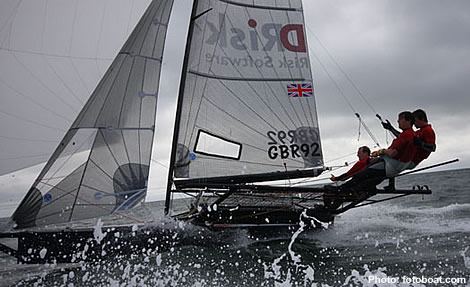
So who is sailing in the class now and where have they come from?
The UK Nationals proved there to be four stand-out teams. Leading the charge are the Mears brothers, who sail out of Stone Sailing Club, and who have done the hard yards from Oppies up through Cadets, Larks and the B14 winning UK and European championship titles on the way. They bought their original Pica in 2006 from a team in Munich, allegedly on a whim the day after spotting Rob Greenhalgh’s yellow flier RMW Marine in a magazine...
After several seasons developing the first Pica, this year the Mears, Jamie and Stewart, and Tristan Hutt (an ex-49er sailor), have traded up to a new Team Pica, formerly Rob Greenhalgh’s Benny, the newest boat in the UK fleet. In this they have just dominated the UK Nationals with a string of bullets worthy of the boat’s previous JJ Giltinan-winning owner. Earlier this year at the Europeans/Mark Foy Trophy in Denmark, Pica finished second behind John Winning’s team from Sydney, to claim the European title, finishing ahead of other notables from down under like Alex Vallings, Jonathan Whitty and Grant Rollerson and past JJ winner American Howie Hamlin.
Photo by www.georgieclarke.com
Second at the Nationals this weekend was UK-based American, Mason Woodworth and Investec, the Ovington-built ex-White Stuff, which he purchased in 2005. Woodworth is a well known match racer, having once been part of Ian Williams’ World Match Racing Tour winning team and he is a three time US Match Racing Champion. He and his crew had been match racing together since 2001 before they deciding to try their hand in the 18.
At the Nationals, Jack Rogan’s Hyde Sails team was pipped at the post for the final step on the podium by Richard Allen’s new Carsington team including crew Richard Bland and Peter Shaw. Compared to the top two, both these teams are very much newer to the 18, the Hyde Sails crew only starting out last year, aboard the former Rockport, the boat that originally secured Britain’s first win of the JJ Giltinan Trophy down in Sydney in the hands of Tim Robinson. While at times at the Nationals they were jockeying with Pica they suffered gear failure on a couple of days that put them out of the running.
Carsington’s result at the Nationals was the surprise, the team of Richard Allen, Pete Shaw and Richard Bland, who herald from Carsington Water in Derbyshire, having only moved into the 18 this season. This spring they bought the Mears’ former Pica following illustrious careers taking them through the GP14, 420, Dart 18, 505, Laser 4000, RS800 and RS700.
The Carsington crew could not be described as being in their first flush of youth, but then neither are class luminaries such as John Winning, Trevor Barnabas and Howie Hamlin, who still succeed in putting together top results.
Photo above by Eddie Aldridge
Fifth place at the UK Nationals went to Steve McLean’s team on Hurley Palmer Flatt (HPF). McLean has been in and out of the 18 since the 1980s and bought Trevor Barnabas’ Omega Smeg from Australia in 2005, having owned six 18s prior to that including Ericsson, Pink Hammer and Ella Bache. McLean sails out of Hayling Island and also competes in the Laser SB3 and Moth classes, and on the 18 now has with him the experienced Nick Pratt and Simon Eatwell, both South Africans. They have been developing the boat and acquired the former Investec square topped main and rig package.
Rutland Skiff is sailed by Tom Hill, Miguel Andrew and Mark Kudlinski, who – no surprises – sail on Rutland Water. They acquired the Murray 18 Gill in October last year. Hill and his crew are currently students and have come up through Toppers and Lasers, Fireflys, Laser 3000, Laser 5000 and RS 800.
Photo by www.georgieclarke.com
Having been blasting around in the boat over the winter, Ben Clothier sailed with the Rutland Skiff crew at the first event this season. He says that it is important for newcomers to the 18 to get someone with experience to go sailing with them to show them the ropes. “Often people find them difficult to control, end up upside down and more often than they’d care to and give up. So what is required is for them to sail with someone who’s done it before, to pull the strings correctly, put enough kicker on, get the crew weight in the right place, do the things in the right order and all of a sudden you can get the boat around the course and it goes 5 knots faster. Then it becomes an experience where they’d quite like to race it...”
Also at the Nationals was Matts Watts’ Cardiff-based team on Aftica/Severn Sails, a B18 dating back to the early 1990s. Watts kept his team under the radar until the first event this season when on occasions they were beating the experienced Steve Mclean around the course. However they struggled in the brisk conditions of the Nationals with their new main with its giant square top.
New to the UK circuit this year too are Matt Kiddle and Tom Kiddle with Stu Tinner aboard KKT, who usually sail out of Calshot, all having come from the Cherub class. They were wooed into the 18 after attending an open day the UK class ran. “They realised it was all do-able and that they actually were capable of sailing it, so they investigated and took the plunge,” says Clothier. They bought the Gill Wet’n’Wild boat (ex Dickies of Bangor), an Ovington dating back to 2001.
So eight at the Nationals – not a bad turn out. Clothier agrees: “I am absolutely delighted with that. My goal was 10 and I nearly got it. I was unlucky that a few people couldn’t make it, but they nearly did.”
Among the other contenders, who weren’t at the Nationals are Craig Hepplewhite based on Loch Lomond, who this year bought the Ronstan boat. Hepplewhite and John Annan started out in Toppers, worked their way through the 420 national squads and moved into 4000s and then 49ers.
Up in Pwllheli, Andy Miles’ White Knight team sails a 1996 B18, once upon a time the Sunday Telegraph/Base One, while down in Looe, Cornwall is the former SP Systems belonging to Pete Greenwood.
Otherwise 18s are dotted around the country with the Jobsons’ Rock Doctors in Lancashire, a B18 owned by Joe Pester in the Lake District and others at Queen Mary SC, Draycote and Ullswater and another B18 at Hayling and a handful more.
Clothier is actively gunning to get as many of these out racing as he can. “It wouldn’t be hard to get another five sailing or 12 boats. Getting 10 for the Nationals was absolutely realistic - it just required everyone who was current to go sailing. So to get another two more is within the realms of possibility too.”
And of course we haven’t mentioned the likes of Andy Budgen and Jarrod Simpson, who typically only campaign boats down in Sydney.
This year the UK class have held three events to date, with the last taking place over 8-9 October in Looe. Throughout the season they have been attempting to introduce a ‘stadium sailing’ element to the racing, setting courses with marks close to shore, etc.
In addition there is the European circuit, which this year has so far visited Lake Balaton in Hungary, followed by the Europeans/Mark Foy Trophy in Denmark, the German Grand Prix in Travemeunde with the season concluding on Lake Urnsee, Switzerland over 23-25 September.
The UK class is now looking to 2012 and is anticipating holding four more events, including the Nationals, as it did this year. These will be timed around other international events, particularly the European circuit and the Mark Foy Trophy.
“The main thing is to get the UK Grand Prix to a state where we are attracting a bit of sponsorship just to help us run the events and take the media side of it a bit further, and reinvest in the circuit,” says Clothier. “I think we have got a very good base for it now in terms of boats and understanding the type of events that work and trying out some new locations.” Sandbanks being one.
Clothier points out that the time could be ripe for a re-surgence in 18 sailing. The 18 originally paved the way for the likes, originally, of the popular Laser 4000 and 5000, and more recently the RS classes, supplemented by older classes like the Cherub and International 14 and of course the advent of the 49ers into the Olympic Games and subsequently the 29er. As a result today there are a lot more people with skiff-sailing know-how. “It isn’t like it was in the 1990s when people jumped into an 18 and had to work out how to sail a skiff. Now they jump into an 18 knowing how to sail a skiff, but just have to work out the nuances of the 18, dealing with the extra loads and so on, so that should help potentially increase numbers,” says Clothier. He adds that they are also seeing interest from more ‘experienced’ dinghy sailors, like the Carsington crew, realising that they don’t have to be in their 20s to go 18s sailing competitively – as John Winning and Howie Hamlin are testament.
In terms of buying equipment it is healthy that there are teams in the class at different levels, with Pica and Investec at the top, more than able to hold their own internationally, down to the newbie teams. This allows kit to filter down through the ranks.
Obviously you can spend as much as you like on an 18ft skiff program, but a top end campaign, buying a boat of JJ Giltinan Trophy-winning calibre, would cost £35-40,000 while at the opposite end at present it is possible to buy an older boat for around £5,000 and upgrade it as and when funds allow.
“Particularly after major events, like the Mark Foy, top teams sell carbon rigs with square topped mains on,” says Clothier. “They are very keen to see new people join the class and move their way up the equipment level. So with £10,000, provided you spend your money carefully, you can do a lot with a boat and you can race competitively in Europe.”
Photo above by Eddie Aldridge
Clothier points out that Jack Grogan’s Hyde Sails is a good example of a team which has come into the class on a modest budget, buying a relatively old boat and working it up to a good standard. “They have been helped by other class members who have been able to sell more up-to-date bits of kit, particularly masts and sails, etc to help them with that. They are now in a situation where their boat handling means they can go out and focus on racing with a piece of kit that works well. They are a great example of people can get going in the class relatively quickly.”
Good news for anyone looking to get in at the upper end is that Ovington once again have moulds and can build new boats. According to Chris Turner, they are currently waiting for the new style deck modifications to come from Australia and when these arrive and they have installed a new oven, he reckons they will be in a position to build boats later this year.


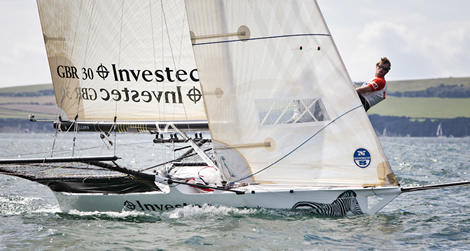
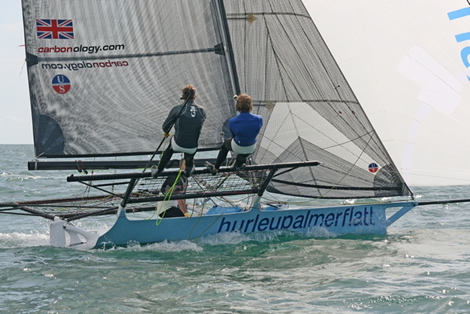
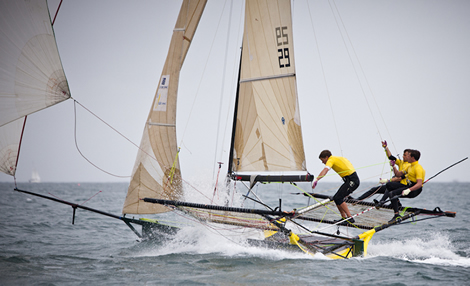
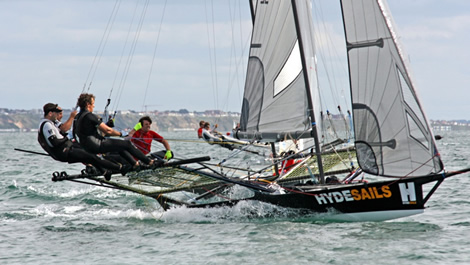








Latest Comments
Add a comment - Members log in